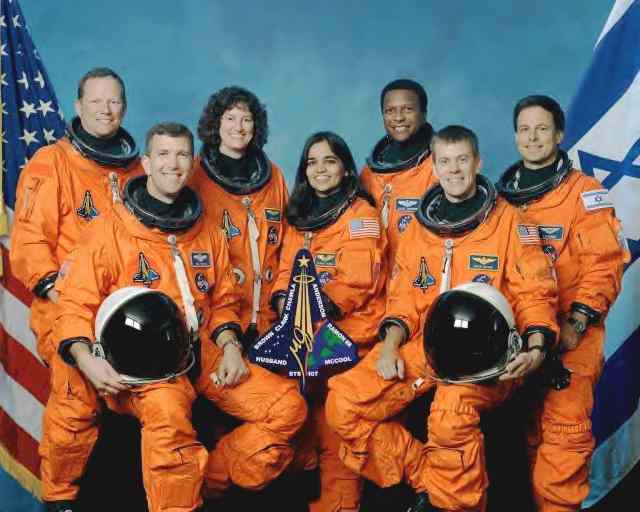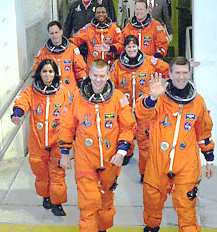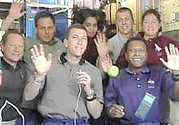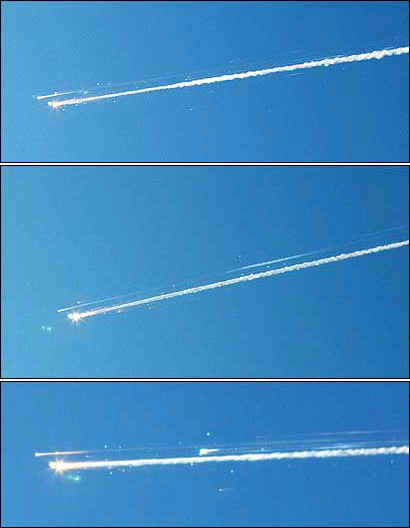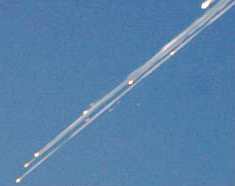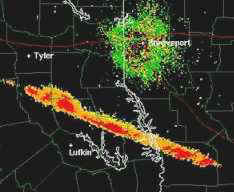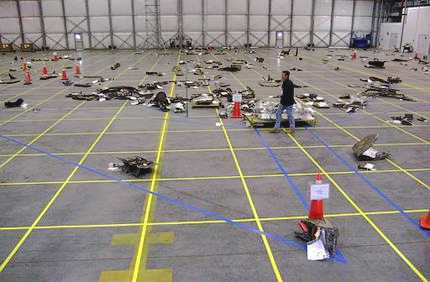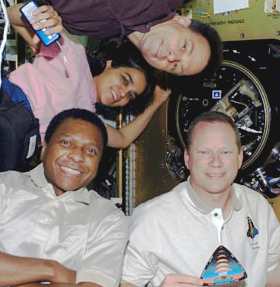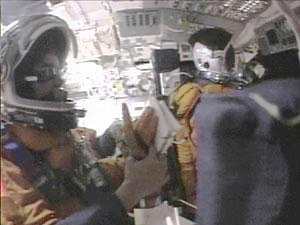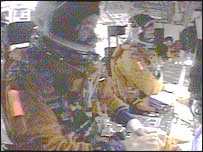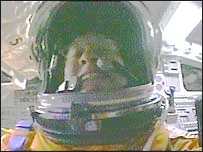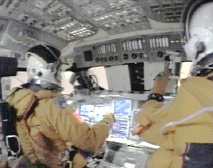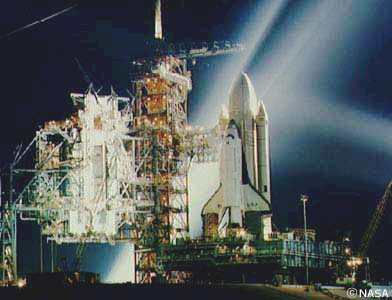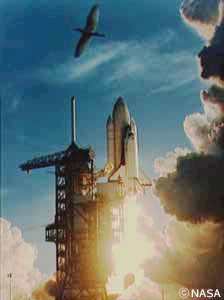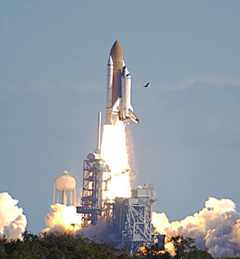THE CREW COLONEL RICK D. HUSBAND NAVY CMDR. WILLIAM C.
MCCOOL AIR FORCE LT. COL.
MICHAEL P. ANDERSON NAVY CAPT. (DR.) DAVID
M. BROWN NAVY CMDR. (DR.) LAUREL
B. CLARK KALPANA CHAWLA Just before she lifted off on the Columbia space shuttle for her second trip to space, she told reporters that her inspiration to take up flying was J.R.D. Tata, who flew the first mail flights in India. "What J.R.D. Tata had done during those years was very intriguing and definitely captivated my imagination," Press Trust of India quoted her as saying on Jan. 16. After her first flight in 1997, she had told News India-Times of seeing India's Himalayan Mountains and mighty rivers from space. "The Ganges Valley looked majestic, mind boggling," she said. "Africa looked like a desert and the Nile a vein in it." Chawla was born 41 years ago in Karnal, about 80 miles north of New Delhi, in northern Haryana state. She emigrated to the United States from India in the 1980s and became a U.S. citizen. Chawla graduated from the Tagore School in the mid-1970s and later received a degree in aeronautical engineering from Punjab Engineering College. After moving to the United States, she earned an advanced degree in the same field from the University of Texas and a doctorate in her specialty from the University of Colorado at Boulder in the late 1980s. She became an astronaut in 1994. On her first space flight, she was blamed for making mistakes that sent a science satellite tumbling out of control. Other astronauts went on a space walk to capture it. India Today magazine reported that NASA had absolved Chawla, rating her a "terrific astronaut," and saying the accident had resulted from a series of small errors. On her 1997 flight, Chawla said that as the shuttle repeatedly passed over India, especially New Delhi, she pointed it out to the other crew members and said, "I lived near there." Chawla's parents, two sisters and sister-in-law had gone to the United States to watch her flight, a family friend, Arun Sharma, said outside the home of her brother, Sanjay, in New Delhi. ISRAELI AIR FORCE COL. ILAN RAMEN "There is no more important period in which it is good to make people happy," he said in a pre-flight phone conversation with Israel's Prime Minister Ariel Sharon. "It is an honor to represent the State of Israel." In a conversation from space with Sharon that was carried live on television, Ramon said, "From here in space, Israel looks like it appears on the map--small but beautiful." Ramon was born on June 20, 1954, in Tel Aviv, and received a bachelor of science degree in electronic and computer engineering from the University of Tel Aviv in 1987. A colonel in the Israeli Air Force, Ramon, 48, was a former fighter pilot and weapons specialist who took part in Israel's famed 1981 bombing of the Iraq's nuclear reactor at Osirak, near Baghdad, before it became operational. Ramon clocked more than 3,000 hours as a combat pilot in A-4, Mirage III-C and F-4 Phantom fighter planes, and he logged more than 1,000 in the U.S.-built F-16. He was an F-16 squadron commander from 1990-1992. He fought in the 1973 Yom Kippur War and the 1982 war in Lebanon. He was selected to be Israel’s first astronaut in 1997 for a launch that was originally planned for as early as 1999. But at least 18 technical delays postponed the launch for several years. When he learned that he had been selected as Israel's first astronaut, Ramon said in an interview, "I really jumped almost to space." One of the main experiments Ramon was involved in was the filming and tracking of dust particles from sandstorms in the Sahara Desert, and their impact on the climate and environment. One of the coordinators of the experiment, Yehoyahin Yosef, a professor of planetary physics at Tel Aviv University, gave Ramon a small, pocket-sized scroll of the Torah that Yosef had used to study for his bar mitzvah when he was a 13-year-old boy in the Bergen-Belsen concentration camp.
16 MINUTES FROM HOME Debris from the space shuttle Columbia streaks across the sky over Tyler, Texas Saturday. Amateur photographer Dr. Scott Lieberman shot a series of photos showing the break-up of the space shuttle from his backyard in Tyler early Saturday.
Tile Damage Was Feared E-Mails Show NASA Safety Experts' Photo Request Rejected Worried NASA safety experts asked the Defense Department to photograph damage to the space shuttle Columbia's heat-reflecting tiles during its doomed final flight, but other space shuttle officials canceled the request before it could be carried out, according to internal space agency e-mails disclosed today. The U.S. Strategic Command, which routinely monitors objects in space, had "spun up" to respond quickly to the request, but was told not to proceed because NASA had concluded the tile damage posed no "major problem," the NASA e-mails state. The reversal came before NASA engineers had finished their analysis of how serious the tile damage problem might be, the documents show. And some engineers still worried -- up to the day before the shuttle's disastrous landing attempt on Feb. 1 -- that the damage might allow a stream of hot plasma to penetrate the shuttle's left wing and destroy its landing gear and other vital mechanical systems. "If the wing is off, or has a big hole in it, you're not going to make the runway," one engineer warned on Jan. 31. Another engineer speculated that day that such a breach might indeed lead to an "LOC," or loss of crew, in NASA's vernacular. The e-mails revealed that the disaster followed considerable internal debate about Columbia's safety during reentry, which NASA has largely kept hidden until now. It also provides fresh evidence that flight managers were ill-informed about the scope and depth of the engineers' concerns. The warnings detailed in the e-mails were not passed along to engineers or senior NASA officials outside of the Johnson Space Center, agency officials have acknowledged. Nor were flight controllers informed that an analysis of the landing risks remained incomplete on the 12th day of the 16-day mission, when they formally dismissed the problem and elected not to consider any change in the flight or landing routine. "Why are we talking about this on the day before landing, and not the day after launch?" asked one alarmed engineer on Jan. 31, expressing frustration that the issue had not been resolved much earlier. "The message of open work was not clearly given" to a deputy flight director before the 12th day, another NASA engineer complained. A board appointed by NASA to review the calamity has concluded that the left wing of the shuttle was breached by superheated air somewhere near the landing gear doors -- precisely the scenario spelled out in several e-mails. But the board has not yet determined whether the breach was caused by damage to the tiles during the shuttle's launch, as the engineers surmised. The e-mails make clear that shuttle program officials, in deciding to withdraw a request for Defense Department imagery, effectively overruled the Jan. 22 request of engineers in the Johnson Center's Safety, Reliability, and Quality Assurance Office. In 1986, after the loss of the shuttle Challenger as a result of agency missteps, a presidential investigating commission said that maintaining the independence of NASA's safety office was critical to protecting shuttle crews. But when it came to requesting images during Columbia's flight, the e-mails released today raise questions about the extent of the safety office's independence. NASA spokesman John Ira Petty said tonight that the request for photographs was canceled because the safety experts' request was not "official" and did not go through proper channels. It stemmed from "miscoordination," he said. In an e-mail to colleagues on Jan. 29 summarizing the contacts with the Department of Defense, J. Steven Stich, an engineer in the Johnson Center's office of maintenance, mechanical and crew systems, wrote, "I told them that we did not require the data on this mission, and . . . they could turn off their system which was in high gear to get the data." But Stich also expressed second thoughts in that memo. "In hindsight, I probably should have let them go since they had worked it very hard," he said about the Strategic Command. "They may not respond as well next time, since we 'cried Wolf.' . . . ." Another shuttle program official, Roger Simpson, sought to cover NASA's apparent embarrassment over the reversal on Jan. 23. "Thank you for the enthusiastic response to the request," he wrote to Strategic Command officials in an e-mail also sent to members of the team managing the mission. "We truly appreciate the effort and apologize for any inconvenience the cancellation of the request may have caused." One of the NASA e-mails refers to photographs that could have been taken by a "spy telescope." Strategic Command officials declined today to explain what was meant by the reference to an "enthusiastic response," or to explain exactly how they might have photographed the shuttle. That gets into "information of a classified nature," a spokesman said. In Simpson's e-mail, he wrote that NASA's request had been based "on a piece of debris, most likely ice or insulation from the ET [shuttle external fuel tank], that came off shortly after launch and hit the underside of the vehicle. Even though this is not a common occurrence, it is something that has happened before and is not considered to be a major problem." NASA officials in Houston said today they could not explain why Simpson -- who could not be reached for comment -- had expressed such certainty about the gravity of the problem days before the agency's technical review of the debris strike was completed. "I just do not have an answer," said Petty, the space center spokesman. A NASA spokesman in Washington pointed to a public statement by shuttle program manager Ronald D. Dittemore several hours after the disaster in which Dittemore cited three reasons for not requesting photographs. He said past Defense Department photographs of the shuttle during flight had been inadequate to assess the degree of damage to any tiles; nothing could be done to repair any tiles anyway; and the "best experts at our disposal concluded that it was a minor problem, not a significant problem." Since the accident, NASA has learned that about 3,200 radar and photographic images of the Columbia during its flight were recorded by U.S. government agencies, including the Defense Department. Most were recorded only incidentally, as the shuttle passed through various radar beams, and no single image has been described as establishing the cause of the shuttle's breakup. But radar images recorded by Defense Department facilities in four states -- unbeknownst to NASA at the time -- recorded a piece of debris coming from the shuttle on the second day of the flight, according to members of the board investigating the accident. While its analysis is not complete, the board suspects the debris is either a piece of the leading edge of the Columbia's wing or a small door that was supposed to snap shut over an outlet for fuel lines. The absence of either one could have been devastating to the shuttle during its fiery reentry into the Earth's atmosphere at 12,000 mph, a board member said. The new e-mails make clear that some NASA engineers in Houston and at the agency's Langley Research Center in Virginia continued to press for a direct examination of the Columbia's wing around the time of a critical Jan. 28 meeting at which the Johnson Center's mission management team decided not to pursue the matter further. "They need to get all the facts in early on -- such as look at impact damage from the spy telescope," wrote engineer Carlisle C. Campbell Jr. on Jan. 27. "Any more activity today on the tile damage or are people just relegated to crossing their fingers and hoping for the best?" Langley engineer Robert Daugherty asked on Jan. 28. "I have not heard anything new," Campbell replied. The e-mails spotlight the key role played in all these deliberations by the space shuttle office responsible for the orbiter's maintenance, mechanical and crew systems. The debate over the Columbia's possible fate took place mostly among the members of this group, and in the end their judgment that the tile damage posed no risk to the crew played a large role in the mission management team's decision to dismiss the problem. Jeffrey V. Kling, an engineer in the group who was present in the flight control room during the Columbia's reentry, said in an e-mail on Jan. 31 that while he was worried about the inadvertent deployment of the landing gear as a result of a breach of the wing, he was optimistic that "we can manage the drag" on the vehicle and the crew could always bail out at a low altitude. "The rest of the [more dire] cases are great big what-ifs," he wrote. In an interview arranged by NASA public affairs today, Kling said that "we never anticipated" what actually happened. Much of the technical analysis related to landing risks was coordinated by David Lechner, a young engineer in the maintenance group who worked for the United Space Alliance, a NASA contractor company formed in 1996 by Boeing Co. and Lockheed Martin Corp. to manage shuttle operations. The company's fee arrangement with NASA includes a multimillion-dollar penalty if a flight must be canceled or truncated after launch. "We have been discussing and continue to discuss all the possible scenarios, signatures, and decisions," Lechner wrote in an e-mail one day before the disaster. "Like everyone, we hope that the debris impact analysis is correct and all this discussion is mute." NASA Engineer Warned of Shuttle Breach A NASA safety engineer warned days before Columbia broke apart that he feared the shuttle was at risk for a devastating breach near its left wheel, and he suggested people in the space agency weren't adequately considering the threat. "We can't imagine why getting information is being treated like the plague," the engineer wrote in one of a number of e-mails released Friday that describe greater concerns about Columbia's safety in the days before its breakup. Other documents NASA released show that Columbia may have been struck by as many as three large chunks of foam that smashed against delicate insulating tiles as it took off, not just the one previously acknowledged. Robert Daugherty, an engineer at NASA's Langley research facility in Hampton, Va., did not indicate that he believed the breach would cause Columbia to break apart during its fiery descent. "No way to know, of course," he wrote. But Daugherty warned in his e-mail on Jan. 29 about a possible breach near the seal of Columbia's wheel compartment that could have been caused by damage to the shuttle's thermal tiles there. He seemed mostly worried about the risks of pilots struggling to land Columbia with one or more tires damaged by extreme heat. "It seems to me that if mission operations were to see both tire pressure indicators go to zero during entry, they would sure as hell want to know whether they should land with gear up, try to deploy the gear or go bailout," Daugherty wrote. Senior NASA officials have steadfastly supported assurances by The Boeing Co., a contractor, since the accident that Columbia was expected to be able to return safely despite possible tile damage along its left wing. They also have maintained that concerns expressed in e-mails among midlevel engineers such as Daugherty were part of a "what-if" analysis, and that even these engineers were satisfied with Boeing's conclusions. "During the flight, no one involved in the analysis or the management team or the flight team raised any concerns," NASA spokesman James Hartsfield said Friday. But the e-mails disclosed in Washington raise questions about the assurances by Boeing, including underlying assumptions about the likelihood of damage from a large chunk of breakaway foam and whether damage to Columbia might have been caused by falling ice. The e-mails also include references by Daugherty and another Langley employee, Mark J. Shuart, about secrecy within NASA about the study of risks to Columbia. Shuart wrote Jan. 28 to two other employees, referring to the foam strike, "I am advised that the fact that this incident occurred is not being widely discussed." The e-mails, which never were passed to senior mission controllers in Houston during Columbia's flight, will be turned over to the board investigating the accident, board spokeswoman Laura Brown said. All seven astronauts died in the breakup Feb. 1. The e-mails had been sought since last week by news organizations under the Freedom of Information Act. Employees at NASA's headquarters here published them Friday with little fanfare on the agency's Web site. Among the e-mails were two written after the breakup. Daniel D. Mazanek of the Spacecraft and Sensors Branch at Langley wrote Feb. 7 that the debris that struck Columbia might have been ice, not foam from the external fuel tank. Boeing had calculated that a chunk of foam weighing 2.67 pounds was responsible. But Mazanek estimated that a chunk of ice the same size would have been more damaging because it would weigh 63.4 pounds, "the equivalent of a 500-pound safe hitting the wing at 365 mph." Last week, NASA disclosed a similar e-mail by Daugherty. He wrote two days before Columbia's breakup about risks to the shuttle from "catastrophic" failures caused by tires possibly bursting inside the wheel compartment from extreme heat. Daugherty was responding in that e-mail to a telephone call Jan. 27 from officials at the Johnson Space Center asking what might happen if Columbia's tires were not inflated when it attempted to land. Daugherty cautioned in the e-mail disclosed earlier that damage to delicate tiles near Columbia's landing gear door could permit dangerous temperatures causing one or more tires to burst, perhaps ending with failures that would place the astronauts "in a world of hurt." In other documents released Friday, a report by Boeing employees said that cameras saw three large pieces of debris, each up to 20 inches long, that shattered into a shower of particles after striking Columbia along its left wing. The report, among those supporting Boeing's assurances to NASA that Columbia could return safely, was dated eight days before the spacecraft broke apart over Texas. Earlier Boeing reports during Columbia's flight had focused on possible damage from "a large piece of debris," also about 20 inches. NASA released three reports analyzing possible damage to Columbia's insulating tiles. News organizations had previously obtained two of these. The third, dated Jan. 24, indicated the highest risk of damage was along the leading edge of Columbia's left wing, based on the speed and on the angle of the strike as the shuttle roared skyward. The accident board investigating the disaster has said previously that Columbia almost certainly suffered a devastating breach along its wing and possibly its wheel compartment that allowed searing air to seep inside the shuttle during its descent at nearly 12,500 miles per hour. Unusual temperature readings inside the wing began to occur within minutes of its re-entry, far off the coast of California.
In the final minutes of their lives, Columbia's astronauts were cheerful, at times lighthearted. They helped one another in the cockpit, collecting empty drink bags and putting on their spacesuit gloves. The two women mugged for the camera. They remarked on the blast-furnace heat outside - mere minutes before the superheated gases were about to penetrate the left wing and lead to their deaths. The video cassette shown on NASA TV on Friday was found three weeks ago in East Texas. Among the more than 250 videos aboard Columbia - most of them to document scientific experiments - it was the only one recovered that had any recording left. "Looks like a blast furnace," commander Rick Husband says, referring to the bright flashes outside the cockpit windows as Columbia re-entered the atmosphere above the Pacific on Feb. 1. "Yep, we're getting some G's (gravity)," replies his co-pilot, William McCool. "Let go of the card and it falls." "All right, we're at 100th of a G," Husband notes. McCool observes how bright it is outside and calls it amazing. "Yeah, you definitely don't want to be outside now," Husband adds. Says Laurel Clark, seated behind them: "What, like we did before?" drawing a big laugh. The tape ends a minute later - and a full four minutes before the first sign of trouble. The camera almost certainly continued recording. But the rest of the tape was destroyed in the accident, leaving only the initial 13 minutes of tape to be recovered from the reel, said astronaut Scott Altman. He was commander of Columbia's previous mission, a year earlier, and is also part of NASA's investigation team. The small digital camera was mounted at the front of the cockpit, to the right of McCool, who then handed it to Clark. She aimed it at Kalpana Chawla, the flight engineer seated next to her, and asked: "Can you look at the camera for a second? Look at me." Chawla waves at the camera. Clark turns the camera around and smiles into it. As Columbia started its descent through the atmosphere, Clark pointed the camera at the overhead window to show the bright orange and yellow flashes from the superheated gases surrounding the spaceship as it streaked toward a landing in Florida, where all of their families waited. The spaceship broke apart 38 miles above Texas, 16 minutes shy of touchdown. The accident investigation board suspects a break in the left wing let in the scorching air and led to the destruction of Columbia and the deaths of all seven astronauts. Investigators are trying to figure out what caused the breach. Three of the astronauts were seated in the lower deck and are not on the tape: Michael Anderson, David Brown and Ilan Ramon, who became the first Israeli in space with Columbia's launch on Jan. 16. The tape was discovered five days after the disaster, on Feb. 6 near Palestine in East Texas. It was found on the ground, out in the open. It reveals nothing helpful to the investigation, NASA officials say. The space agency acknowledged the existence of the tape Tuesday but put off broadcasting it until Friday, to make sure the astronauts' families could see it first. Through a public relations firm, two of the widows declined to comment on the video; other relatives could not be reached. The tape has a decided home video quality to it, with the camera wobbly and pointed at times at the cockpit ceiling. Husband, a 45-year-old Air Force colonel and second-time space flier, is seen sipping from drink pouches and, along with McCool, putting on gloves. Everyone is in a bright orange flight suit, with a helmet on but the visor up. Husband explains the bright images outside as Columbia zooms down through the atmosphere and gently reminds his crew to put on their gloves and check their suit pressures. The images, portraying a businesslike routine, yet eerie in retrospect, show flight-deck activity beginning around 8:35 a.m. EST as Columbia soared 500,000 feet above the south-central Pacific Ocean. It continues until 8:48 a.m., when the shuttle was over the eastern Pacific, southwest of San Francisco, at an altitude of about 250,000 feet. Four minutes after that the first signs of overheating appear. Another seven minutes later, Mission Control loses contact. And 32 seconds after that, all communication ends as the spaceship shatters over Texas. Columbia was traveling 18 times the speed of sound when it came apart. The fact that any video was preserved is "remarkable," said Charles Figley, director of the Traumatology Institute at Florida State University. "Some might view it as a miracle," Figley said. "Suddenly here is a postcard of these men and women." He added that the video should provide additional peace of mind for the astronauts' families, because it shows them happy and doing what they loved. Dr. Edward Rynearson, a psychiatrist at Virginia Mason Medical Center in Seattle, agrees that because the images are positive, they should provide some solace. "It's not towers collapsing or blood on the sidewalk and yellow crime scene tape," Rynearson said. "I don't think the images will be directly associated with the way they died." It is evident by the video that none of the astronauts had a clue about what lay ahead. Earlier this week, NASA officials said Husband was notified about the tank debris that smacked into the left wing barely a minute after liftoff along with the results of an analysis concluding damage to the thermal tiles posed no safety threat. He was said to be satisfied with the results. On the Web: NASA:/ http://spaceflight.nasa.gov Shuttle Rescue Might Have Been PossibleCAPE CANAVERAL, Fla. (AP) - May 23, 9:31 PM EDT NASA could have launched another shuttle to rescue the Columbia astronauts if it had realized the severity of the wing damage early on and decided it was worth the extreme risk to the second ship and crew, the chief accident investigator said Friday. Retired Navy Adm. Harold Gehman Jr., chairman of the Columbia Accident Investigation Board, said that the question was put to NASA earlier this month and that the space agency's preliminary findings indicate that such a rescue would have been technically feasible. Space Shuttle Columbia
|
